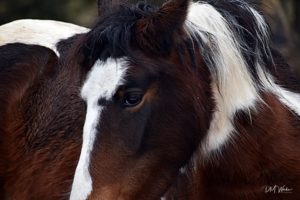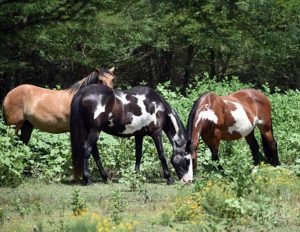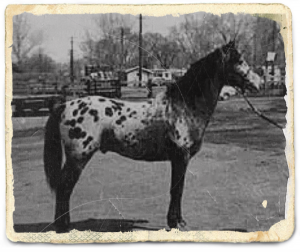
Choctaw and Cherokee Horses
Choctaw and Cherokee horses are known for their hardiness, vigor, and adaptability. Their disposition is typically an easy-going one making it easy to train them with a gentle and patient hand. These horses are people-oriented and can be more loyal than you best dog friend. Although they make excellent trail and endurance horses, they have the potential to do so much more.
These horses are not bred for their height but rather for their stamina and build. Averaging 13.5 hands to 14.2 hands, they can easily carry adults with minimal effort and outlast most other breeds when traveling many miles a day. Most breeders will tell you these are the most uncomplicated keeping horses as they rarely suffer health issues or need veterinarian care.
What Makes Up A Choctaw or Cherokee Horse?
For us to understand the history of the Choctaw and Cherokee horses we must journey to the beginning of their existence as we know it today.
Let us start by clarifying that neither the Choctaw nor Cherokee horse should be considered a breed but rather a strain of tribal-type horses.
Native American Tribal Horses
Traveling back to the Choctaw and Cherokee tribes, who were avid horse breeders in their original territories, and who began breeding the Spanish horses they owned. The more adept the tribes became at horse breeding, the better quality of tribal horses were being raised. This gained these horses a good reputation which is mentioned explicitly in any historic travel journals.
The horses they bred were Spanish and were obtained at first from the chain of missions across the deep south and west of the Mississippi in early Spanish colonial days.
Even after the government removal in the mid-1800s when Choctaw and Cherokee tribes were moved from the southeast into today’s Oklahoma, the tribes continued to breed their horses.
Oklahoma's Tribal Herds
The base of Oklahoma horse herds was brought in from the southeast on the “Trail of Tears.” Due to the Choctaw and Cherokee tribes becoming mediators between western tribes and the U.S. Government, there is little doubt some western horses were added to the mix.
It would not be hard to imagine an exchange of horses between tribes during the many meetings during that time.
Preserving Tribal Horses
Several individuals and families played an essential part in preserving the tribal horses.
The Whitmire family line, which includes horses from the Corntassle family, is a Cherokee line of horses that can be traced back to the removal of the tribe from Etocha, Georgia in 1835. The line may go back further as local court records from 1775 indicate the Whitmire and Corntassle families had herds of horses at that time.
The Whitmire line horses were always kept within the line on the female side. However, outside stallions were occasionally introduced and were of Mexican, Choctaw, or Comanche breeding, making them Colonial Spanish Horses.
Some of the Comanche stallions came from the Black Moon Comanches of Oklahoma and were of leopard-type color patterns. There was at least one Mexican stallion who was a buckskin leopard.
The outside stallions were carefully and specifically selected for inclusion within the Whitmire line. The criteria were to choose those which were as similar to the Cherokee strain as could be had. Many Cherokee horses that remain are gaited and have unusual color patterns, including seeral medicine hat paints.
Preserving the Choctaw Horse
Families who held a part in helping preserve the Choctaw horses in the very early years included the Brames, Crisps, Selfs, Helms, Thurmans, Trotters, Carters, and a handful of others.
These families ran their horses on open range areas where other types of horses were not kept.
Several of the above-mentioned families had hundreds of consistent Spanish-type horses with widely varying colors, including “Spanish roan” sabino type, leopard and blanketed patterns, and other colors such as overo paints.
Choctaw horses are occasionally gaited and are notably quick. Hal Brame, Choctaw breeder, was well known for taking his favorite little paint horse to parties and dances and would make wagers with other horse owners on races over 50 yards. In his lifetime Hal took a lot of money from Quarter Horse and Thoroughbred owners who subsequently went away with increased respect for the small Indian horse.
Dispersal of many large herds has since taken place due mainly to the death of elderly breeders. From the hundreds of Choctaw and Cherokee horses that were available in 1975, it is estimated that only 50 pure Choctaw and Cherokee horses could be assembled in 1988. The American Livestock Conservancy estimated less than 300 pure-blooded horses remained as of 2008. Today we estimate those pure-blooded horses at 500 head.
The Rickman's Efforts
Most of today’s Choctaw horses can be found in Bryant and Darlene Rickman’s herds or in herds descended from theirs.
In 1980 Bryant and Darlene began their efforts in preserving the Choctaw/Cherokee/Huesteca herds and are some of the these horse’s most prominent advocates. Fortunately, many more are starting to see the importance of saving these historically valuable horses and support their continued existence.
Various registries have many horses of partial Choctaw breeding, so the Choctaw strain has made a broad impact on today’s general Colonial Spanish Horse breed. A few noted stallions: KaMaWi, Choctaw, and Chief Pushmataha had a significant influence in the SMR, SPBH, and the Southwest Spanish Mustang Association (SSMA).
Where Are They Today?
Today the Rickman Spanish Mustang Choctaw horses are located on private pasture in Choctaw County, Oklahoma.
We want to make note that though many have suggested pure Choctaw horses freely roamed the Blackjack Mountain in southeast Oklahoma as recent as 2007, it is simply untrue.
When the Rickman family began the conservation of Choctaw/Cherokee/Huesteca horses there were very few pure-blood Choctaw horses running that mountain. Due to their importance there was never were more than a handful. Most were already living on private pasture either leased or owned by the Rickmans when the horses were removed from the mountain in 2007.
Information gathered for this story came from Dr. Phillip Sponenberg’s, DVM, PhD “Choctaw and Cherokee Horses” article with added facts by the Rickman Spanish Mustang library.


